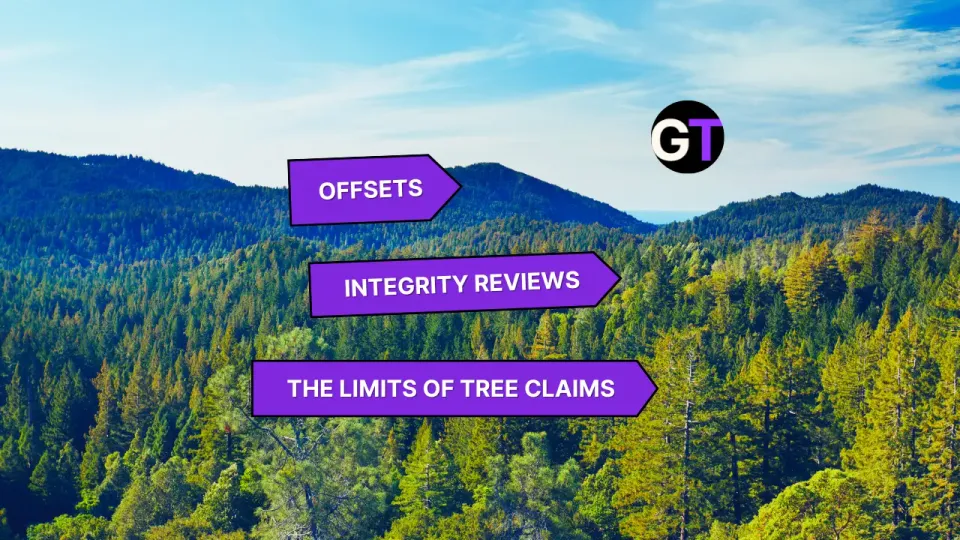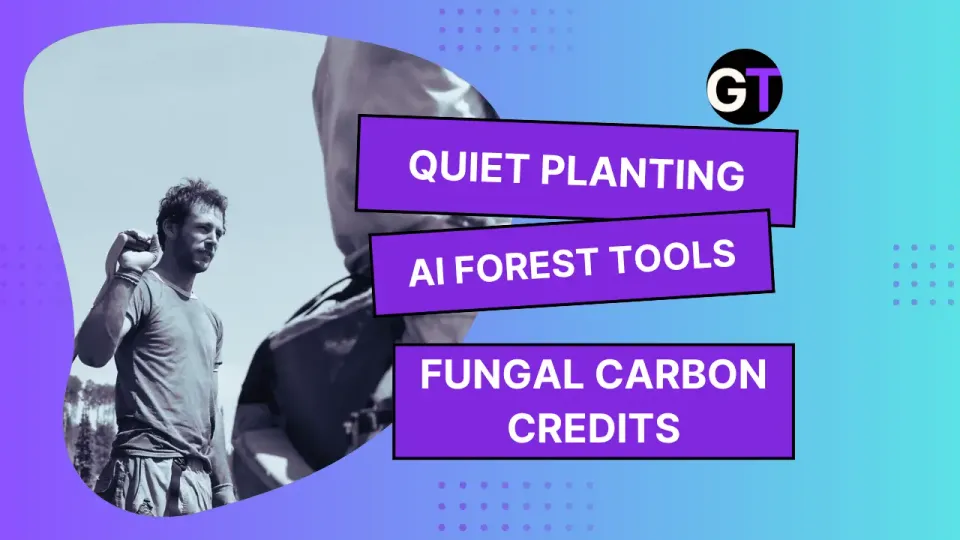Carbon Markets Wobble, Biodiversity Demands Proof
Automation, accountability, and offsets: how tech and trust are redefining the future of forestry. Weekly forest news June 13, 2025.

Forestry Faces AI Shake-Up: Up to 30% of Jobs at Risk, but Data-Driven Gains Loom
AI is reshaping forestry logistics—from pest control to transport planning—with big efficiency wins. A new study finds up to 30% of field jobs could be automated, but barriers like poor data and infrastructure persist. Pairing AI with drones, IoT, and blockchain may offer a smarter, more transparent timber supply chain.
💬 Can AI-powered forestry balance automation with better forest management and job resilience?
👉👉 Read the full report in Future Transportation
Mast Reforestation Faces Legal Challenge Amid Carbon Credit Market Shifts
Seattle-based Mast Reforestation, known for its vertically integrated model of planting post-wildfire forests and selling ex ante carbon credits, is the subject of a whistleblower lawsuit alleging misleading business practices. The former senior director of business development claims the company overstated the value and demand for future carbon credits to potential partners. Several unnamed former employees voiced similar concerns. Mast, which previously rebranded from DroneSeed and recently pivoted to biomass burial, says it does not comment on ongoing litigation. The case highlights growing scrutiny of high-risk, forward-looking carbon offset models amid declining demand.
💬 Can carbon projects rooted in future projections retain trust as investor expectations shift toward verifiable impact?
👉👉 Read more in OPB
Are Biodiversity Claims in Carbon Projects Backed by Evidence? New Study Puts Them to the Test
A new study in Nature Communications Earth & Environment analyzed 92 forest carbon offset projects to assess how well they demonstrate benefits for biodiversity. While nearly all projects claimed to support biodiversity, less than 40% provided any measurable evidence to back these claims. The study highlights a critical gap between marketing and verification in the carbon offset space, especially as biodiversity co-benefits become a key selling point. Researchers call for more standardized, transparent frameworks to ensure nature-based claims are substantiated.
💬 As carbon markets evolve, should we demand proof—not just promises—when it comes to biodiversity?
👉👉 Read more in Nature Communications Earth & Environment
Biodiversity Risk Tools Fall Short of the Mark, Study Finds
Speaking of biodiversity, investors racing to assess biodiversity risks are turning to software tools—but a new study warns they may be flying blind. An analysis of eight widely used impact tools reveals major inconsistencies in company rankings, poor methodological transparency, and weak ties to real-world impacts. Without better data and standards, biodiversity finance could be misinformed at best.
💬 Are biodiversity risk ratings reliable enough to guide nature-positive investment strategies?
👉👉 Read the full paper on SSRN
Philippines’ National Greening Program Exposed: ‘Regreening’ Masking Deforestation
An in‑depth investigation by Lighthouse Reports reveals the $ billions‑seedling program is failing its mission—satellite mapping of 150K+ sites shows forest loss on 1 in 25 hectares during supposed replanting. Short‑term land tenures, cash‑crop monocultures, and weak oversight mean many “protection” areas are bare—and greenwashed under the guise of restoration.
💬 Can the NGP be redeemed with long‑term tenure, native species, and real enforcement?
👉👉 Dive deeper in Forest Fraud: National Greenwashing Program on Lighthouse Reports
This Week in Forest Finance, June 12
From carbon credit surges to refugee reforestation funds, the latest Ground Truth column tracks the rising tide of nature-based investments. WRI reports adaptation projects yield high returns but still struggle to attract funding. Peru’s new Amazon reserve wins global support by centering Indigenous leadership, while Togo commits CFA11B to reforestation. Meanwhile, carbon pricing revenues cross $100B, but prices remain too low to drive real change. Plus: updates from UNHCR, WeForest, Rainforest Trust, and ERS’s acquisition of Equitable Earth.
💬 Are nature-based investments finally catching up to their climate potential?
👉👉 Read our weekly column in Ground Truth
Biodiversity Offsets Often Fail to Deliver Net Gains, New Study Finds
A global review of 916 biodiversity offset projects reveals that most do not achieve their intended goal: no net loss of nature. Researchers found that only 13% of projects could demonstrate that biodiversity outcomes were monitored or achieved, and nearly half lacked clear outcome goals entirely. The study, published in Forest Ecology and Management, highlights that many offsets fail due to vague regulations, poor enforcement, and a reliance on promises of future gains to justify immediate habitat destruction. Authors urge policymakers to strengthen regulations and demand more robust evidence when approving offset plans.
💬 Can tree planting and restoration efforts avoid the same pitfalls by demanding clearer outcomes from the start?
👉👉 Read more in Forest Ecology and Management
Planting Trees Can Help Forests After a Fire
When megafires burn too hot to leave seeds behind, people step in to replant. A new piece from The Nature Conservancy follows forest managers like Catherine Schloegel, who help reestablish ponderosa pine forests in Colorado's burn scars. With hotter fires, climate stress, and seed shortages, reforestation has become a human-powered effort requiring seed collection, nursery expansion, and climate-smart planting layouts. But without more investment, much of the Western U.S. may be too scorched to recover.
💬 Can reforestation efforts scale fast enough to meet the rising demand after megafires?
👉👉 Read more from The Nature Conservancy
How Much Reforestation is Really Possible?
A new study revises global reforestation potential way downward—by up to 92%—highlighting just how context-dependent tree planting really is. After reviewing 89 maps and modeling eight scenarios, the researchers found between 6 and 195 million hectares may be realistically restorable, depending on social, ecological, and legal constraints. The takeaway? There’s no universal reforestation blueprint—only layered tradeoffs and tailored goals.
💬 Can more grounded numbers help cut through reforestation hype and guide smarter action?
👉👉 Read more in Nature Communications
Community Sawmills: A Surprisingly Sharp Tool for Forest Protection
A new study shows that giving Mexican communities more control over timber production—by letting them own and operate their own sawmills—can seriously curb deforestation and encourage forest regrowth. Looking at over 220 forestry ejidos in Quintana Roo, researchers found that ejidos with community sawmills reduced deforestation by 3.6 percentage points and saw increased reforestation. The kicker? These results held up even after controlling for population changes, suggesting it's not just rural flight at play. The implication: vertical integration isn’t just an econ buzzword—it could be a secret weapon in climate and biodiversity battles.
💬 Could supporting local mills be the unexpected win-win for climate and communities?
👉👉 Read more in Ecological Economics
Mapping Old Growth: How Rare Trees Shape the Map
A new study in Canadian Journal of Forest Research finds that old-growth forest maps vary depending on how rare features like large trees are defined—and how small or large the mapping plots are. Using LiDAR and satellite data from Finland, researchers discovered that rarer definitions of old growth (like stands with very large trees) led to more variation and less agreement between datasets. This means mapping strategies must carefully match conservation goals.
💬 Do we want to protect common old growth or only the rarest giants?
👉👉 Read more in the Canadian Journal of Forest Research

Edited by Chris Harris

This work is licensed under a
Creative Commons Attribution 4.0 International License.





